
A railcar is a self-propelled railway vehicle designed to transport passengers. The term "railcar" is usually used in reference to a train consisting of a single coach, with a driver's cab at one or both ends. Some railway companies, such as the Great Western, termed such vehicles "railmotors".

The British Rail Class 207 (3D) diesel-electric multiple units were built by BR at Eastleigh in 1962. The fleet had a lifespan of 42 years. The Southern Region class 201 to 207 DEMUs are nicknamed 'Thumpers' due to the noise their engine units make.
The South Gippsland Railway was a tourist railway located in South Gippsland, Victoria, Australia. It controlled a section of the former South Gippsland railway line between Nyora and Leongatha, and operated services from Leongatha to Nyora, via Korumburra, the journey taking about 65 minutes.

The Wonthaggi railway line is a closed railway line located in South Gippsland, Victoria, Australia. Its primary purpose was to serve the State Coal Mine but the line also provided passenger and general goods services. The line was opened in 1910 and closed in 1978.
The Deniliquin railway line is a broad-gauge railway line serving north-western Victoria, Australia. The line runs from the New South Wales town of Deniliquin into Bendigo, before turning south-south-east towards Melbourne, terminating in Docklands near the central business district. It is a major trunk line both for passenger and freight trains, with many lines branching off from it.
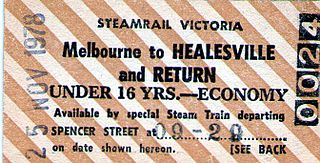
The Healesville railway line, in Melbourne, Australia, was the non-electrified continuation of the suburban Lilydale line, extending into the Yarra Valley. The line closed in the 1980s, but a heritage railway group, the Yarra Valley Railway, is working to retain part of the line between Yarra Glen and Healesville.
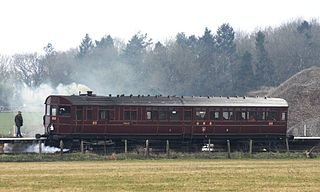
The steam rail motors (SRM) were self-propelled carriages operated by the Great Western Railway in England and Wales from 1903 to 1935. They incorporated a steam locomotive within the body of the carriage.
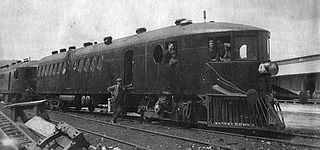
The McKeen Railmotor was a 6-cylinder self-propelled railcar or railmotor. When McKeen Company of Omaha, Nebraska, U.S.A., first unveiled the car in 1905, the McKeen was among the first engines with a distillate-fueled motor. Revisions to the McKeen car led to the modern self-propelled gasoline rail-motor vehicle, and the "contours of the porthole windows, the front-mounted gasoline engines, and other features anticipated the streamline concept."

The Diesel Electric Rail Motor (DERM) was a type of railmotor operated by the Victorian Railways in Australia.

The DRC was a class of railmotor operated by the Victorian Railways on its country rail network in Victoria, Australia. The cars were built by Tulloch Limited in New South Wales, and featured aluminium and steel construction, air-conditioning, and twin diesel engines with hydraulic transmissions.

The CPHrail motors were introduced by the New South Wales Government Railways in 1923 to provide feeder service on country branch lines.
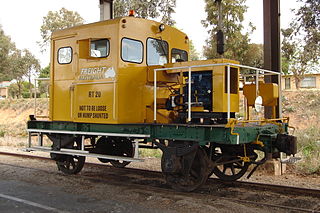
The Victorian Railways rail tractors are a small shunting unit used by the Victorian Railways of Australia for moving railway wagons in at country stations and private sidings. Varying in power output and size, they are agricultural tractors on top of a four-wheeled steel rail wagon frame. RT1 was of a different design to the remainder of the class and is preserved at the Newport Railway Museum, Victoria.
The MT type carriages were railmotor trailers, used on the Victorian Railways (VR) in Australia.

The family of Walker railmotors were a type of diesel railcar operated by the Victorian Railways in Australia.
This article contains information on Victorian Railways rolling stock that do not fit into other categories. These were for the most part "one-offs"; many were not classified.
Musk railway station is in Musk, in central Victoria, Australia. It was opened in September 1881 under the name of Musk Creek, the name being shortened to Musk in 1905. The station closed with the line on Monday, 3 July 1978.
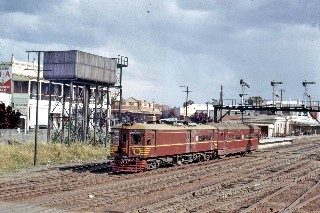
Creamy Kate is a former New South Wales Government Railways railmotor, numbered 38. It is an evolution of the CPH rail motor class.

Two models of the Brill railcar were operated by the South Australian Railways between 1925 and 1971. Introduced to run on country rail services, the "Barwell Bulls" serviced most of the state's railway lines until they were eventually replaced by both the Bluebird and Redhen railcars. The last units were withdrawn in 1971.

The 400/500 class rail motors are diesel trains built by New South Wales Government Railways primarily for use on regional lines throughout NSW. The trains have since been phased out following a rationalisation of country branch line rail services in November 1983. The 400 Class power cars were built in 1938 at the Eveleigh Carriage Workshops, while the 500 Class trailer cars were built by Ritchie Brothers at Auburn.















